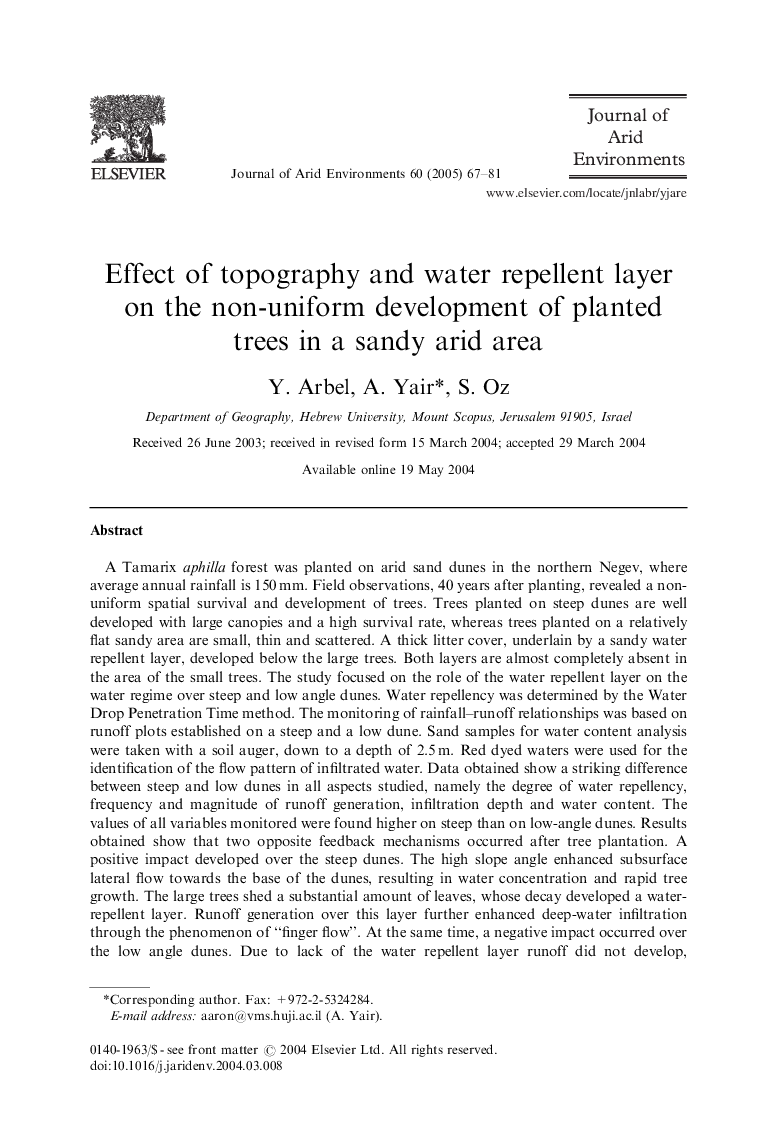| کد مقاله | کد نشریه | سال انتشار | مقاله انگلیسی | نسخه تمام متن |
|---|---|---|---|---|
| 9447980 | 1305581 | 2005 | 15 صفحه PDF | دانلود رایگان |
عنوان انگلیسی مقاله ISI
Effect of topography and water repellent layer on the non-uniform development of planted trees in a sandy arid area
دانلود مقاله + سفارش ترجمه
دانلود مقاله ISI انگلیسی
رایگان برای ایرانیان
کلمات کلیدی
موضوعات مرتبط
مهندسی و علوم پایه
علوم زمین و سیارات
فرآیندهای سطح زمین
پیش نمایش صفحه اول مقاله

چکیده انگلیسی
A Tamarix aphilla forest was planted on arid sand dunes in the northern Negev, where average annual rainfall is 150Â mm. Field observations, 40 years after planting, revealed a non-uniform spatial survival and development of trees. Trees planted on steep dunes are well developed with large canopies and a high survival rate, whereas trees planted on a relatively flat sandy area are small, thin and scattered. A thick litter cover, underlain by a sandy water repellent layer, developed below the large trees. Both layers are almost completely absent in the area of the small trees. The study focused on the role of the water repellent layer on the water regime over steep and low angle dunes. Water repellency was determined by the Water Drop Penetration Time method. The monitoring of rainfall-runoff relationships was based on runoff plots established on a steep and a low dune. Sand samples for water content analysis were taken with a soil auger, down to a depth of 2.5Â m. Red dyed waters were used for the identification of the flow pattern of infiltrated water. Data obtained show a striking difference between steep and low dunes in all aspects studied, namely the degree of water repellency, frequency and magnitude of runoff generation, infiltration depth and water content. The values of all variables monitored were found higher on steep than on low-angle dunes. Results obtained show that two opposite feedback mechanisms occurred after tree plantation. A positive impact developed over the steep dunes. The high slope angle enhanced subsurface lateral flow towards the base of the dunes, resulting in water concentration and rapid tree growth. The large trees shed a substantial amount of leaves, whose decay developed a water-repellent layer. Runoff generation over this layer further enhanced deep-water infiltration through the phenomenon of “finger flow”. At the same time, a negative impact occurred over the low angle dunes. Due to lack of the water repellent layer runoff did not develop, preventing the positive effect of water concentration and deep-water infiltration required for a sustainable development of planted trees.
ناشر
Database: Elsevier - ScienceDirect (ساینس دایرکت)
Journal: Journal of Arid Environments - Volume 60, Issue 1, January 2005, Pages 67-81
Journal: Journal of Arid Environments - Volume 60, Issue 1, January 2005, Pages 67-81
نویسندگان
Y. Arbel, A. Yair, S. Oz,